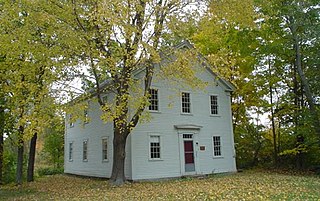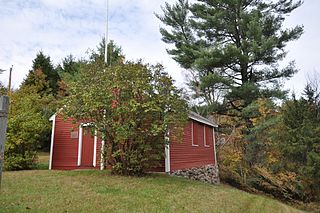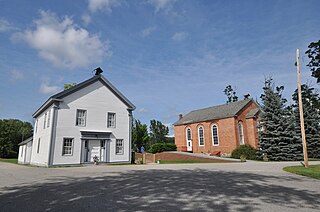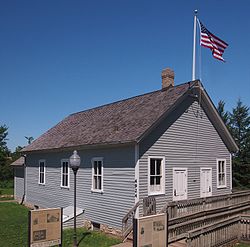The Edina School District is the public school system for most of the city of Edina, Minnesota. It is also referred to as the Independent School District (ISD) 273. There are approximately 8,500 students, K-12, served by 1139 teachers and support staff in six elementary schools, two middle schools and one high school.

Minnehaha Grange, No. 398 was organized on December 23, 1873, with members from Edina Mills, Richfield Mills, St. Louis Park, and Hopkins. The National Grange of the Order of Patrons of Husbandry, commonly known as the Grange, is an organization dedicated to the principles of "progressive agriculture" for the "social fraternity of the farmers". The organization was founded in 1867 by Oliver Hudson Kelley in Elk River, Sherburne County, Minnesota and quickly spread across the country. The fraternity tackled issues such as railroad prices, and providing education to farmers.

The Little Red Schoolhouse, also known as Briggs Schoolhouse, is a historic schoolhouse in Farmington, Maine. The one-room wood-frame schoolhouse was built in 1852, and originally stood on the Wilton Road at Red Schoolhouse Road. It served Farmington as the Briggs District school until 1958, and is one of the community's few surviving district school buildings. It was then used as a space for special needs students before being finally closed in 1969. It was moved the Franklin Agricultural Society fairgrounds on High Street in 2007. The building was listed on the National Register of Historic Places in 1972. It is open to the public during the annual Farmington Fair.

The Eureka Schoolhouse is a historic school building at 470 Charlestown Road in the Goulds Mill village of Springfield, Vermont. Built in 1785, it is the oldest surviving schoolhouse in the state. It is the centerpiece of a small historic site operated by the state. The school was listed on the National Register of Historic Places in 1971.

The Square Schoolhouse is a historic schoolhouse at the junction of New Hampshire Route 156 and Ledge Hill Road in Nottingham, New Hampshire. Built about 1850, it is one of the best-preserved mid-19th century schoolhouses in southern New Hampshire. It served as a school until 1920, and is now a local museum. It was listed on the National Register of Historic Places in 1980. It is named not for its shape, but for its location in Nottingham Square.

The Dry Mills Schoolhouse is a historic schoolhouse on Game Farm Road in Gray, Maine. Built about 1857, it is the town's last surviving single-room district schoolhouse, and is now a local museum. The building was added to the National Register of Historic Places listings on December 13, 1996.

Saints Peter and Paul Catholic Church is a former parish church of the Diocese of Sioux City. The historic building is located in Pocahontas, Iowa, United States. The parish served the Bohemian community that lived in the Pocahontas area. It was listed on the National Register of Historic Places in 1994.

St. Mary's Church is a historic turn-of-the-20th century Catholic church located in the unincorporated community of Adair, 12 miles northeast of Kirksville, Adair County, Missouri, on Missouri Route 11. An example of Romanesque Revival architecture, it is one of the few wood-frame structures in that style still remaining in the United States. St. Mary's was constructed in 1904, and was added to the National Register of Historic Places in 1974. It is now owned and managed by Friends of St. Mary's, a non-profit preservation organization.

The Indian Stream Schoolhouse is a historic school building on Tabor Road in Pittsburg, New Hampshire. Built in 1897, it is one of the town's few surviving 19th-century district schoolhouses. It was listed on the U.S. National Register of Historic Places in 2011, and the New Hampshire State Register of Historic Places in 2007. It presently serves as a local history museum, open for tours by appointment.

The East Andover Village Center Historic District encompasses the historic village center of East Andover, New Hampshire, United States. The 2.2-acre (0.89 ha) district includes a cemetery and three buildings: the Andover Congregational Church, the Highland Lake Grange Hall, and the East Andover Schoolhouse. It is located at the corner of New Hampshire Route 11 and Chase Hill Road. The district is unified by the appearance of the three buildings, and their styling, which is predominantly vernacular 19th century.

The North Weare Schoolhouse is a historic school building on Old Concord State Road in northern Weare, New Hampshire. Built about 1856, it is a stylistically distinctive vernacular mixing of Federal, Greek Revival, and Italianate styling. It is the most architecturally distinctive of Weare's surviving 19th-century schoolhouses. It was used as a public school until 1952, and then served as a grange hall until the 1980s. The building was listed on the National Register of Historic Places in 1995.

The Little Red School House, or the District No. 7 Schoolhouse is a one-room schoolhouse on New Hampshire Route 10, south of downtown Newport, New Hampshire. Built in 1835, it is one of the state's few surviving pre-1850 district schoolhouses, and one of the least-altered of that group. It served the city as a school until 1891, and was acquired in 1951 by the local chapter of the Daughters of the American Revolution. It is open as a museum during the summer months. The building was listed on the National Register of Historic Places in 1980.

The Washington Common Historic District encompasses a cluster of three civic buildings and the town common in the center of Washington, New Hampshire. The town common began as a 2-acre (0.81 ha) parcel acquired in 1787, and the current town hall followed in 1789. It is a two-story wood-frame building which originally served as both a civic and religious meeting house. The adjacent Gothic Revival Congregational Church was built in 1840. The third structure is the Schoolhouse, a 2+1⁄2-story two-room school built in 1883. The district was listed on the National Register of Historic Places in 1986.

The Beaver Meadow School is a historic school building at 246 Chapel Hill Road in Norwich, Vermont. Built in 1922, it is a rare late example of a one-room schoolhouse, made further distinctive by the survival of its original schoolroom interior. The building was listed on the National Register of Historic Places in 2013.

The Upper Stone Schoolhouse, also known as the Scott House, is a historic One-room schoolhouse located east of Vinton, Iowa, United States. Built in 1875, this is an unusual example of a stone one-room school. There was only one other built in Benton County, about 2 miles (3.2 km) to the southeast. The stone schoolhouse was replaced by a wood-frame building to the south sometime between 1905 and 1910 to accommodate the large number of students. It served eight rural sections of farmland from the time. The Scott family, who owned the adjacent farmland, bought the stone school building after it closed and converted it into a house. It was listed on the National Register of Historic Places in 1983.

The Root School is a historic school building at 987 Union Village Road in Norwich, Vermont. Built in 1937, it is a rare late example of a one-room schoolhouse, made further distinctive by the survival of its original schoolroom interior. The building was listed on the National Register of Historic Places in 2013.

The School House and Town Hall is a historic municipal building on Schoolhouse Road, just west of United States Route 7 in the center of Leicester, Vermont. Built about 1858, it is a fine example of late Greek Revival architecture, and is the town's best-preserved district schoolhouse. Its upper floor has served as the town hall since its construction. It was listed on the National Register of Historic Places in 1988.

The West Berkshire School is a historic school building at Berkshire Center and Mineral Brook Roads in Berkshire, Vermont. Built about 1820, it is one of the state's oldest surviving two-room two-story schoolhouses. It was used as a school until 1970. It was listed on the National Register of Historic Places in 1993.

The District 6 School House is a historic school building at 73 Cemetery Circle in Lyndon, Vermont. Built in 1857, it served as a school until 1900, and saw use in the 20th century as a garage, storage facility, and museum. It was listed on the National Register of Historic Places in 2006.

The Cataumet Schoolhouse is a historic school building at 1200 County Road in Bourne, Massachusetts. Built in 1894, it served the town as a schoolhouse until 1934, and then as a community center until 1960. It is a well-preserved example of a 19th-century one-room schoolhouse, and was listed on the National Register of Historic Places in 2019.























